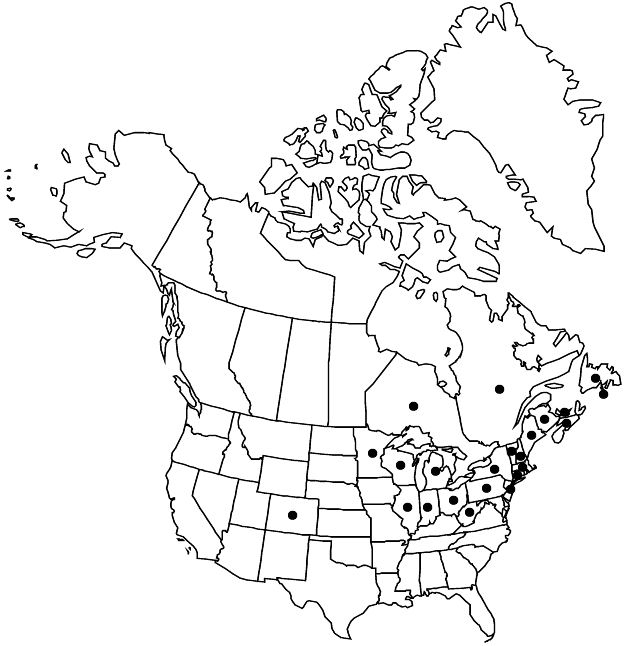Filipendula ulmaria
Trudy Imp. S.-Peterburgsk. Bot. Sada 6: 251. 1879.
Plants cespitose, 12–17 dm. Rhizomes horizontal, stout, 5–10 mm wide, internodes 1–2 cm; root tubers absent. Stems sparsely curly-puberulous distally or glabrous. Leaves: basal 1 or 2, deciduous by flowering; stipules ovate, 0.6–1 cm, base auriculate; lateral leaflets in 2–4 pairs, remote, with smaller intermediate leaflets between them, ovate to elliptic, 2–6 cm, margins doubly serrate; terminal leaflets round, 3–7 cm diam., palmately 3–5-lobed, lobes ovate to lanceolate, margins doubly serrate, apex acute to acuminate, surfaces hairy at least on nerves, hairs appressed, straight to curly, short, or abaxial grayish tomentose. Inflorescences 100+-flowered; branches and pedicels glabrous or tomentose to tomentulose. Flowers: hypanthium concave, becoming slightly convex in fruit; sepals (4–)5(–6), green, spatulate to triangular, 2–3 mm, margins without or with weak midrib, abaxially tomentose puberulent, adaxially glabrous; petals (4–)5(–6), white to cream, orbiculate to obovate, 2.5–5 mm, claws distinct, short, base narrow, margins entire; stamens white, longer than petals. Achenes 6–8, flattened, elongate, twisted, 3–6 mm, glabrous; sessile; styles 1–1.5 mm. 2n = 14, 14+2B (Europe).
Phenology: Flowering summer (Jul).
Habitat: Moist meadows, roadside and railway ditches, near abandoned houses
Elevation: 0–500 m
Distribution

Introduced; St. Pierre and Miquelon, N.B., Nfld. and Labr. (Nfld.), N.S., Ont., P.E.I., Que., Colo., Conn., Ill., Ind., Maine, Mass., Mich., Minn., N.H., N.J., N.Y., Ohio, Pa., Vt., W.Va., Wis., Eurasia.
Discussion
Filipendula ulmaria is cultivated as an ornamental and sometimes escapes. The species is fairly common and relatively persistent or locally spreading from old gardens and thoroughly established well into the wild at some locations in the Maritimes. The native range stretches from Atlantic Europe to eastern Siberia (basin of Lena River), and from the Arctic Circle to the Altai Mountains of southern Siberia.
Two or three varieties or subspecies are often recognized within Europe and Russia in Filipendula ulmaria in the broad sense. Among them, subsp. picbaueri (Podpěra) Smejkal represents a separate species, F. stepposa Juzepczuk, and does not occur in North America. Two other frequently used infraspecific names are subsp. denudata and subsp. ulmaria, the former sometimes also regarded as a separate species. The latter has abaxially grayish tomentose leaves; the former has leaves only minutely hairy along the nerves. The full spectrum of intermediates usually occurs within a single population, and both forms clearly belong to the same species (I. A. Schanzer 1994). Both of them may occur in North America as escapes from cultivation.
The flowers contain tannins and salicylates and are thought to reduce pain and fever, mildly. They have also been used to treat stomach complaints, such as heartburn. Some research in laboratory animals has been conducted to investigate their effectiveness for ulcers, but results are not conclusive. Some laboratory studies appear to show that the flowers and seeds contain a chemical similar to heparin. That and the salicylate component may have some inhibiting effect on blood clotting (O. D. Barnaulov and P. P. Denisenko 1980; S. Foster and J. A. Duke 1990; B. A. Kudriashov et al. 1990, 1991). None of these properties have been documented by well-controlled clinical studies.
Selected References
None.